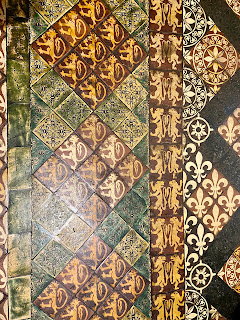The Pope is in Lisbon for World Youth Day, and temperatures are soaring. We escape to Ireland and, with the help of friends, stay in Dublin's (pop 592,713 in 2022 South Georgian Core near Merrion Square. We arrive just in time to grab dinner near the Grand Canal and enjoy the sunset near St Mary's, Haddington Road (Catholic, eighteenth century).
The next day we deal with clouds and cool drizzle – a welcome contrast in weather. We walk to Dublin Castle (eighteenth century) to purchase our Heritage Cards and arrange a tour time. The ticket office books us for the early afternoon, so we have plenty of time to walk around the Castle and Dubh Linn Garden.
We also have time to walk to Christ Church Cathedral (Anglican, twelfth to nineteenth centuries), very close by the Castle. This is a heavy, blocky structure hovering between Romanesque and Gothic. We note the zig-zag crenellations along the upper walls and the anthropomorphic 'faces' of several facades. The gable-ends sandwich a set of flying buttresses, which provide the structure for the larger clerestory openings.
The interior is brightly lit by hanging lanterns and up-lights. The effect is a bit artificial, and while accentuating the sculptural elements, makes photography difficult. Meanwhile, the dazzling floors and richly decorated glass provide plenty of colorful accents. At the far end, there is a blue glow above the altar. A closer inspection reveals this is also from the lighting. The stone above the arches there is gridded with floral patterns, the archivolts and vault ribs repeat a 'saw-tooth' design.
In front of the altar is a quire (choir) space, separated by a free-standing Gothic colonnade. Behind the quire is a large ambulatory, with a series of family memorials, and three small chapels. The Lady Chapel is at the center-rear and includes the glass triptych visible through the Gothic screen from the nave.
In the center medallion, in the vault above the choir is a triangular Shield of the Trinity. Here, the trefoil archways are arranged as seats, with red velvet cushions.
We Return to the Castle for a guided tour, and it begins with the old walls and foundation (twelfth and thirteenth centuries). Dublin is built at the confluence of the Liffey and the Poddle Rivers, but only the Liffey remain visible; the Poddle is here in the basement.
Next, we cross the courtyard to the Chapel Royal (nineteenth century), a lovely Gothic revival building by Francis Johnson. This features an intriguing integration of materials (dark wood, stone, stained-glass – top image) as well as amazing fan-vaulting above the aisle balconies.
Across the middle of the stained-glass panel at the altar, just above The Four Apostles, are the words,"Ecce homo" (top image). The scene is thus Pontius Pilate accusing Christ. At the top of the composition is the Crucifixion and the Resurrection. There are two winged figures on either side of a crowned emblem in the quatrefoil at the very top. Finally, the lighting here makes up for the effort at Christ Church; without intruding, it frames the sculptures just so, and allows the natural to play.
Inside the Castle, we take a trip through the State Apartments: State Corridor, State Drawing Room, Throne Room, and St Patrick's Hall – all very stately.
The brighter sky affords a better image of the Cathedral as we pass on our way to St Audoen's Church (Anglican, twelfth century; twentieth century restoration).
St Audoen's is part restored, part persevered, and part ruin, with wonderfully aged details and architectural elements.


















































































